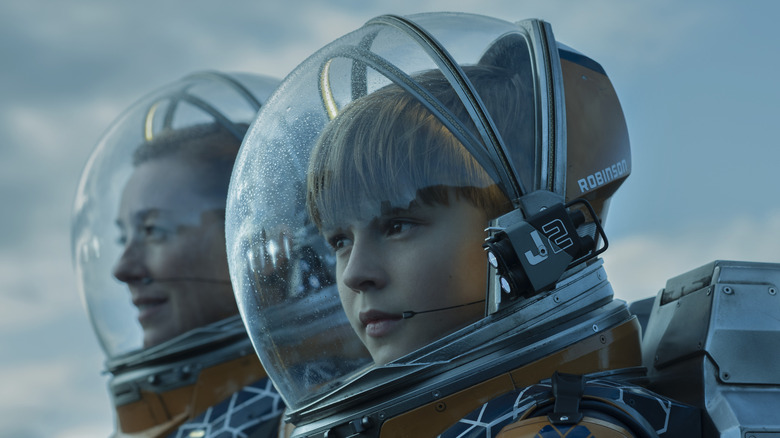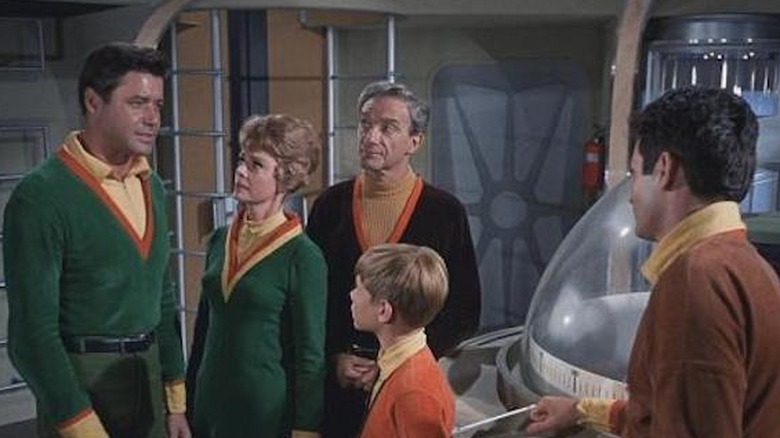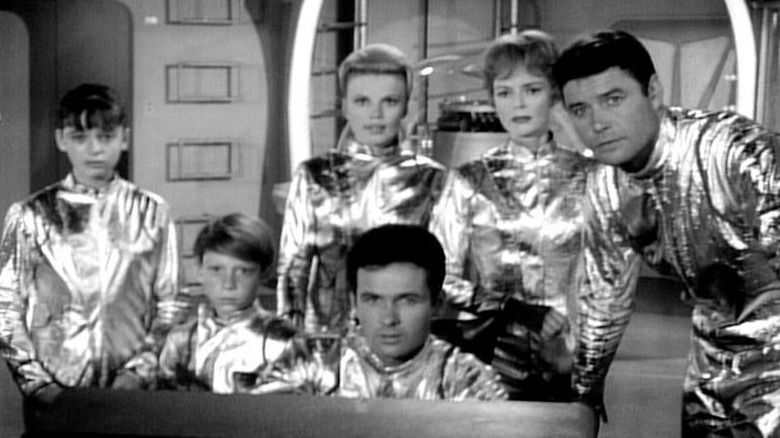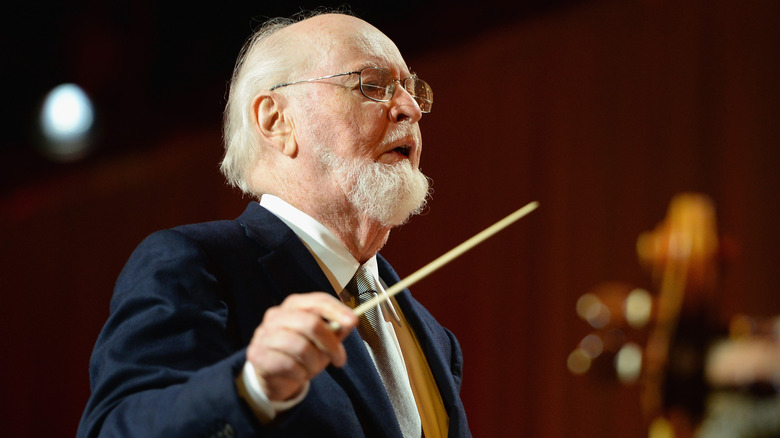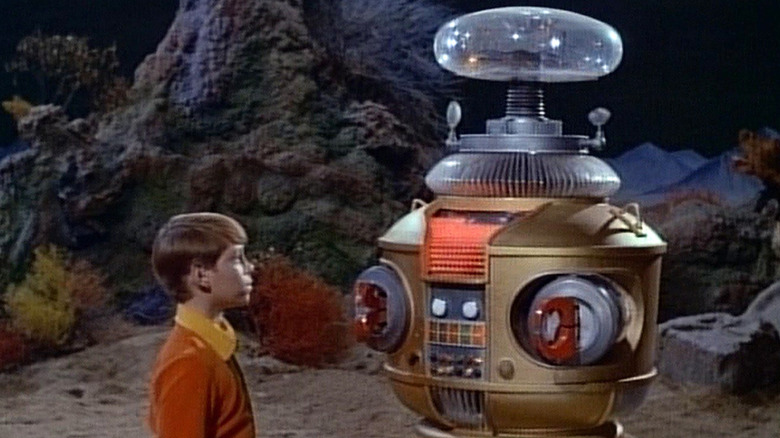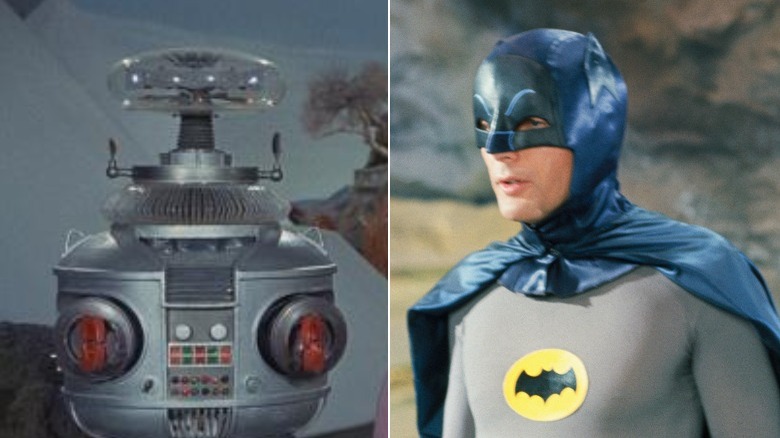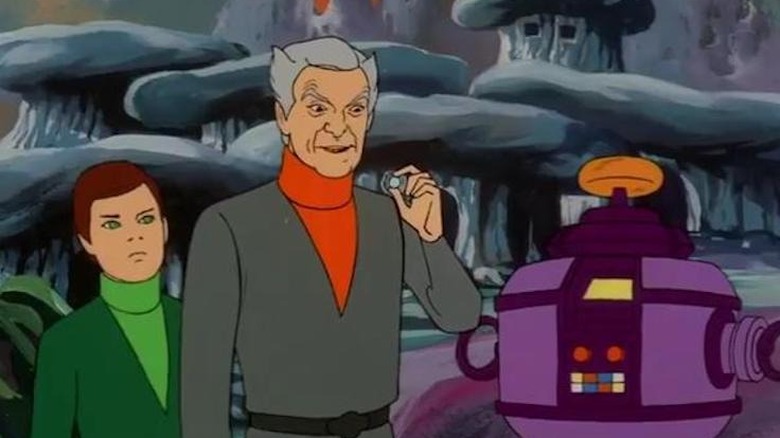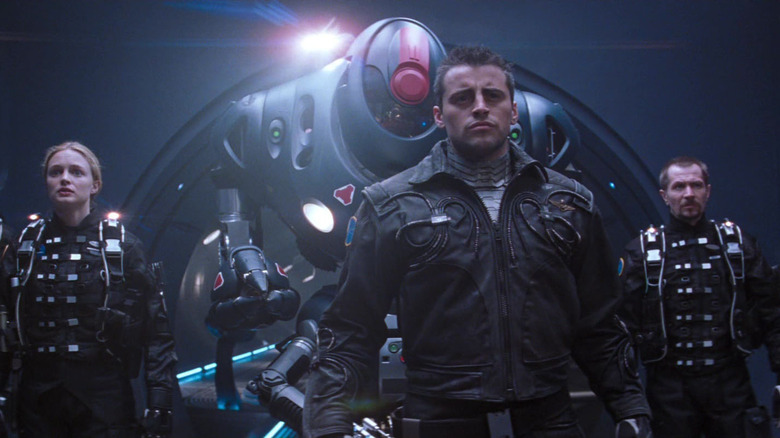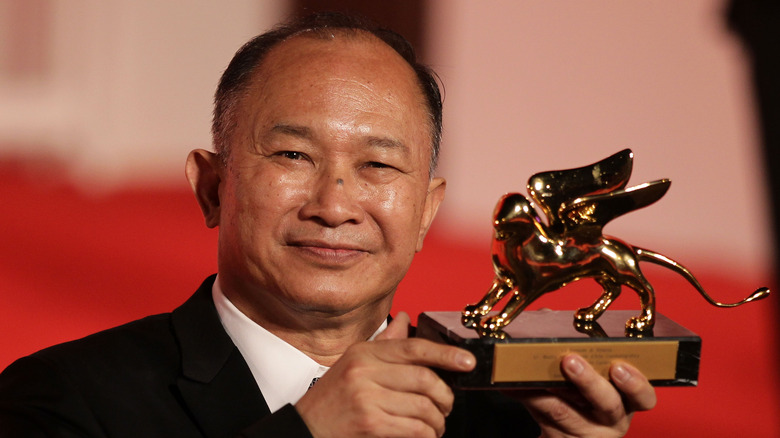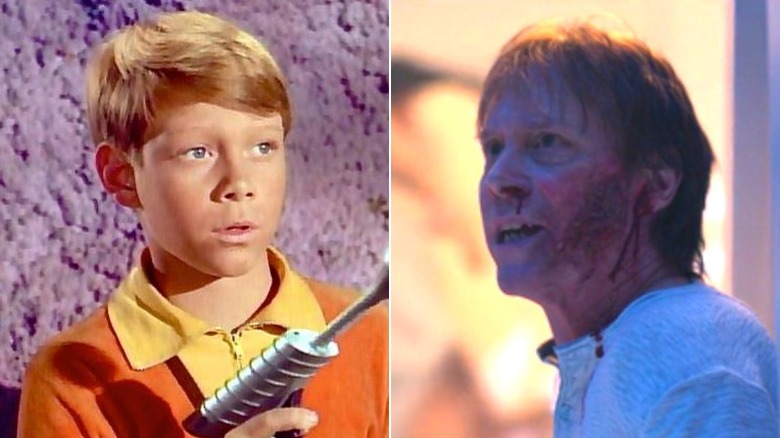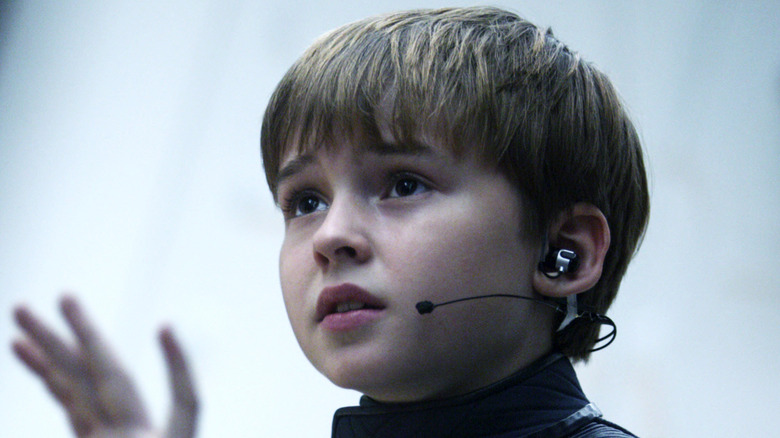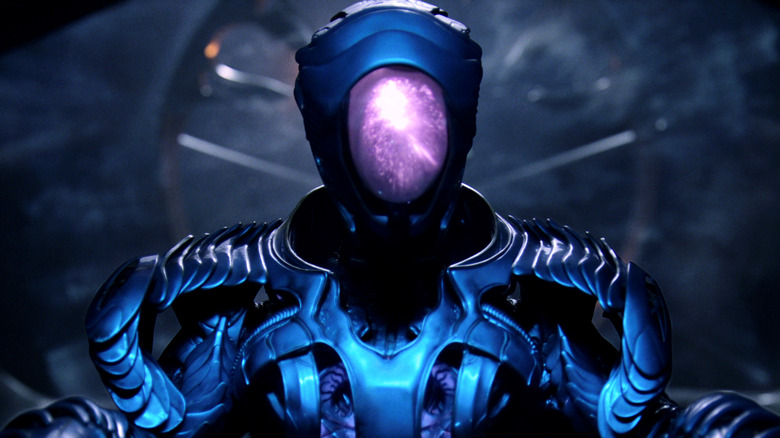The Untold Truth Of Lost In Space
When "Lost in Space" debuted on CBS in September 1965, space science fiction was a rarity on American television. Series creator Irwin Allen pitched "Lost in Space" as a thrilling serialized adventure in which a tight-knit American family must rally together to survive the perils of deep space. The series became better known for its campy and colorful later seasons, which won it a cult following of young and young-at-heart viewers. Canceled after 84 episodes, "Lost in Space" laid mostly dormant until it was revived as a big-budget Hollywood blockbuster in 1998, but this proved to be a false start for the franchise. It would take another decade, but a solid "Lost in Space" reboot finally made it off the ground in the form of a Netflix series in 2018, which completed its planned three-season run in 2021.
Each incarnation of "Lost in Space" has featured its own unique spin on the premise, as well as its own set of behind-the-scenes trivia. Which breakout characters weren't part of the original pilot? How many attempts to revive the franchise have failed? Which "Lost in Space" cast member is also a circus performer? And just what does Batman have to do with all this? Lock your space helmet tight — there's danger ahead!
Lost in Space was Inspired by Swiss Family Robinson
By 1965, film and television producer Irwin Allen had already produced one hit series, a TV spin-off of his film "Voyage to the Bottom of the Sea." For his follow-up, Allen devised a sci-fi twist on "Swiss Family Robinson," an 1812 novel about a shipwrecked family surviving in the wild. Instead of being castaways on a deserted island, Allen's Robinson family would be space-age colonists whose starship is thrown off course on their way to nearby Alpha Centauri. The challenges they face would be more fantastical, but the general idea was the same — the family would have to work together to stay alive and take care of each other as they journey from place to place, looking for their new home.
This actually wasn't the first time this exact premise had been attempted — Gold Key Comics had already launched a comics series called "Space Family Robinson" in 1962. Luckily, Irwin Allen had a working relationship with Gold Key, who was publishing a comics series based on "Voyage to the Bottom of the Sea." Rather than enter into legal action, an agreement was reached that allowed the "Lost in Space" TV series to continue and for the Gold Key series to change its title to "Space Family Robinson: Lost in Space," embracing the confusion to boost sales of the comic.
The Original Series Had Two Pilot Episodes
Every fan of the classic "Lost in Space" knows that the Robinson family sets out on their voyage to Alpha Centauri aboard the Jupiter 2, and that their mission is sabotaged when the sinister Dr. Zachary Smith reprograms their B-9 robot. Except, in the first "Lost in Space" pilot, that's not how it happened. In the original pilot episode, "No Place to Hide," the Robinsons and Maj. Don West embark on their journey aboard the identical Gemini 12, with no Robot or Dr. Smith in sight. This pilot had a budget of over $600,000 (over $5 million in 2021), the most expensive TV pilot ever made at the time. After it was completed, the producers decided some changes were necessary and a second pilot was commissioned. The first five episodes of the series were written to be able to include portions of the footage shot from the original pilot.
According to "Lost in Space: The Ultimate Unauthorized Trivia Challenge," the name of the ship was changed due to NASA retiring the Gemini program in favor of the Apollo missions. Series creator Irwin Allen chose the name Jupiter 2 in tribute to a vessel from one of his own feature films, "Five Weeks in a Balloon." The antagonist Dr. Smith was added in the second pilot in order to give the show a consistent source of character conflict, and ironically enough became the focus of the show. Series story editor Tony Wilson says that Smith, an adult villain whose main foil is a young boy, was inspired by Long John Silver from Robert Louis Stevenson's 1881 adventure novel "Treasure Island." The Robot was, likewise, an addition for the second pilot, and remains the most recognizable character from the series.
John Williams wrote the original music for Lost in Space
Between "Star Wars," "Close Encounters of the Third Kind," and "Superman," audiences are used to hearing the music of maestro John Williams playing over a majestic starfield. But casual fans of the legendary composer may not be aware that, early in his career, John Williams also composed the main theme to 1965's "Lost in Space," as well as the theme that replaced it for Season 3 in 1967.
While each subsequent incarnation of "Lost in Space" sports its own unique musical score, both paid homage to the maestro's Season 3 main title theme. Electronic group Apollo 440 remixed and re-arranged the theme for the end credits of the 1998 film — and this track would go on to become their highest-charting single. Christopher Lennertz's original score for the 2018 Netflix series occasionally quotes from the Williams Season 3 theme, but only sparingly as not to reduce its impact.
The Robot only actually says Danger, Will Robinson! once
If you've heard of "Lost in Space," then you're likely also familiar with the catchphrase, "Danger, Will Robinson!" However, it might surprise you to learn that, like "Casablanca's" "Play it again, Sam" or "Star Trek's" "Beam me up, Scotty," the most famous line of "Lost in Space" was made into a meme by the fans, not by the work itself. While the B-9 Robot from "Lost in Space" is quite fond of repeating the words "Warning!" and "Danger!" and exclaiming that something "does not compute," he only ever actually says the exact phrase "Danger, Will Robinson!" on a single occasion. This occurs in the third season episode "The Deadliest of the Species."
None of this stopped the line from becoming the most oft-repeated reference to the series in popular culture. The phrase was so widely recognizable that the teaser poster for the 1998 film reboot used it as a tagline. The film's official website even used the URL dangerwillrobinson.com. In the 1998 "Lost in Space," Robot repeats the phrase mainly for comedic impact. In the 2018 rebooted series, the Robot rarely speaks at all, but when he does, it's often to say "Danger, Will Robinson."
Lost in Space Lost a Ratings War with Batman
"Lost in Space" first aired on CBS on September 15th, 1965, and immediately made an impact on younger audiences. However, just four months later, the target demographic of "Lost in Space" was introduced to a new sensation on rival network ABC: "Batman," starring Adam West and Burt Ward. "Batman" premiered in January 1966, and aired during the same Wednesday night time slot as "Lost in Space." The US quickly fell into the grips of Batmania, hurting the ratings of "Lost in Space." Fans of "Lost in Space" theorize that competition from "Batman" is what led "Lost in Space" to switch from shooting in black and white to color, and to take on a campier tone. The show's budget was also slashed for Season 3, leading to the same creature effects and stock footage appearing in episode after episode. At this point, the series simply couldn't compete with Adam West's not-so-Dark Knight, and "Lost in Space" came to an end in 1968.
The two casts finally had it out (in as friendly a way as possible) in a 1983 episode of "Family Feud." During the game show's "TV's All-Time Favorites Week," Robinson actors Guy Williams, June Lockhart, Angela Cartwright, and Marta Kristen (as well as Robot suit performer Bob May) teamed up against "Batman's" West, Ward, Lee Mayweather, Yvonne Craig, and Vincent Price. "Batman" won this contest as well and advanced to the next round, where they faced the cast of "Gilligan's Island."
Lost in Space almost returned as a cartoon
In 1973, Hanna-Barbara (the studio behind "The Flintstones" and "Scooby-Doo") produced a 45-minute animated pilot for a revived "Lost in Space." The pilot was written by former "Star Trek" producer Fred Freiberger and featured an entirely new cast of characters, with the exception of Jonathan Harris as Dr. Smith. The story follows star pilot Commander Craig Robinson, his young cousin Link, geologist Deena Carmichael, and a familiar-looking robot called Robon. It is apparently set in a distinct continuity from the original series, the only common factors being the lead characters' surname, some design elements, and the presence of a cowardly Dr. Zachary Smith. The pilot was not picked up for series, and was aired as a standalone product on ABC in September 1973.
This wasn't the only attempt at reviving "Lost in Space" between its cancelation and the 1998 feature film. Bill Mumy, who played Will Robinson in the original series, had grown into a writer and had ambitions to reboot the series himself, but Irwin Allen would not grant him permission to pursue a new "Lost in Space" television series. Mumy was, however, permitted to adapt his pitch into a comics series, which was published by Innovation Comics between 1991 and 1993. Mumy's co-writer on the series, Kevin Burns, would later produce the rebooted "Lost in Space" series for Netflix in 2018.
The 1998 Lost in Space movie was a massive production
When a live-action feature film remake of "Lost in Space" went into production in 1997, it was the most expensive and ambitious project that New Line Cinema had yet attempted. It had a budget of over $100 million and about 700 computer-driven visual effects shots, the most ever for a film at the time.
Producers Richard Saperstein and Akiva Goldsman aimed to turn "Lost in Space" into a high-drama, high-adrenaline action-adventure film. They sought out serious actors for their cast, such as Oscar-winner William Hurt as John Robinson, and even securing Gary Oldman to portray Dr. Smith for a rumored salary of $4 million. On the other hand, they cast "Friends" star Matt LeBlanc as Don West in his first and only attempt at becoming a big-screen action hero. The experiment was a failure, and 1998's "Lost in Space" was panned by critics and didn't make a sequel-worthy box office return.
John Woo directed a Lost in Space TV pilot in 2003
The middling response to the 1998 feature film didn't put the "Lost in Space" franchise to bed for long. Irwin Allen's widow, Sheila Matthews Allen, disliked the dark film version and subsequently sold the rights to "Lost in Space" to producers Kevin Burns and Jon Jashni, superfans of the original series. They initially attempted to create a sequel series, which would feature a new cast but take place in the same universe. This would allow for original cast members to reprise their roles as guest stars. NBC gave the project the green light, but their interest waned after the death of Jonathan Harris, the original Dr. Smith, in 2002.
The following year, Burns and Jashni produced a pilot for a rebooted "Lost in Space," which was directed by none other than John Woo, the acclaimed director behind "Hard Boiled" and "Face/Off." This new take, titled "The Robinsons: Lost in Space," is first and foremost a family drama, starring Brad Johnson, Jayne Brook, and Adrienne Palicki. Instead of Dr. Smith, this series invents a fourth Robinson child named David, the eldest son, who has a contentious relationship with his father. The pilot was not picked up for series, and if you watch the footage (which has since leaked on YouTube), you can get an idea as to why. It's pretty unremarkable television, surprisingly devoid of excitement for a John Woo product.
Burns and Jashni weren't very happy with it, either, but their next attempt at a "Lost in Space" reboot finally took root, growing into the Netflix series that debuted in 2018.
The 2018 series is peppered with tributes to the original cast
The Netflix reboot of "Lost in Space" is a refreshing new take on the premise that goes in some radically different directions. Producers Kevin Burns and Jon Jashni wanted their version to live up to Irwin Allen's original ambitions for "Lost in Space," which he had envisioned as a serious action-adventure program. The new series isn't too precious about its source material (and that's a good thing), but that doesn't mean that the producers aren't interested in dropping a few cute references and cameos along the way.
First and foremost, there's the one-scene appearance of the real Dr. Zachary Smith, whose identity is stolen by a con artist (played by Parker Posey) who uses his name for the rest of the series. The actor who portrays the legitimate Dr. Smith is none other than Bull Mumy, the original Will Robinson. Then, there's the con artist's rarely-used real name, June Harris, which is a riff on Jonathan Harris, the actor who played the original Dr. Smith. Angela Cartwright, the original Penny Robinson, also has a cameo in the series as Smith/June's mother, Sheila, and June Lockhart, the original Maureen Robinson, has a voice cameo as a control tower operator in the show's final episodes. The producers originally planned to have every surviving original cast member make some sort of cameo in Season 3, but shooting during the COVID-19 pandemic made that impossible.
Netflix's Will Robinson, Maxwell Jenkins, was Raised in the Circus
When actor Maxwell Jenkins first took on the role of Will Robinson at age 12, he'd already racked up a handful of acting credits on TV series like "Betrayal" and "Sense8." But his career as a performer actually goes back much farther, all the way to the age of 3, and on a much more bizarre and extravagant stage — Chicago's Midnight Circus. Jenkins is the son of two circus performers who founded the Midnight Circus in 2007, and he's performed alongside his parents and sister Samantha throughout his life. His skills include tightwire walking, juggling, and the "rola-bola" (the act of balancing on a precariously stacked board on top of an un-anchored cylinder.
Jenkins has occasionally returned to the circus since taking on the role of Will Robinson, and says that he practices his circus skills to relieve stress while away on a TV shoot. "Nothing is harder than the circus," said Jenkins while promoting a 2021 outdoor performance with the Midnight Circus.
The Robot is a practical effect (mostly)
The cast of the Netflix reboot of "Lost in Space" features an entirely new take on the Robot, a sentient shapeshifting machine of alien origin. While the Robot is sometimes depicted via CGI (like whenever he's seen stomping around in his four-armed alien form), he is normally depicted via a practical costume effect created by Spectral Motion. Inside the suit is veteran creature actor Brian Steele, who has also portrayed bizarre monsters in feature films like "The Empty Man," "Predators," and the "Underworld" franchise.
Even the swirling lights on Robot's face, which abstractly convey his thoughts and emotions, are created via a practical screen element on the suit's helmet, though this is sometimes replaced with CGI on close-ups. When the Robot or his kin are rendered digitally, they're the product of effects studio Image Engine.
Being a tangible, practical effect may have contributed to the lustful reaction to the Robot on social media following his debut in 2018. "Lost in Space" is geared towards a family audience and generally avoids sexualizing any of its characters, but that didn't stop viewers from posting en masse about the show's "hot robot." This generated a wave of grassroots publicity for the show, to which a grateful but befuddled Netflix Twitter account replied "Y'all need Jesus."
